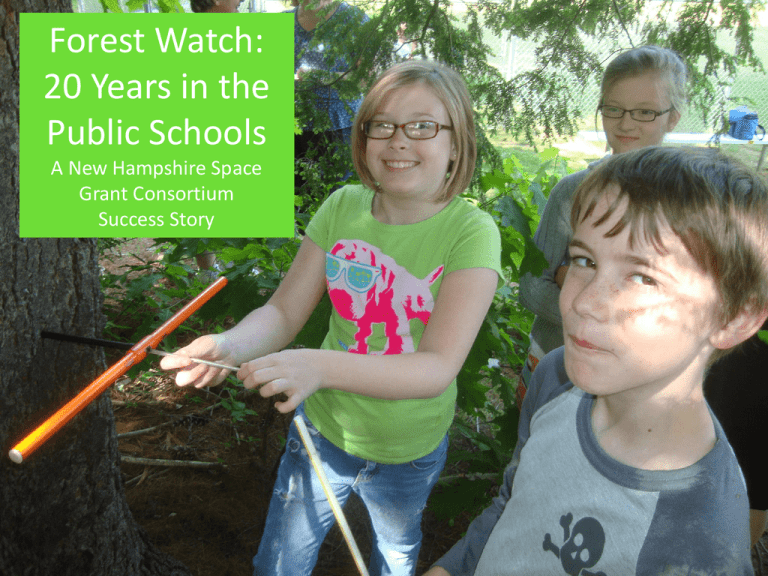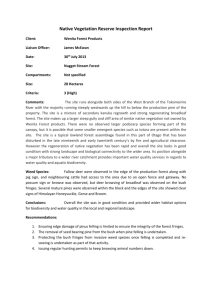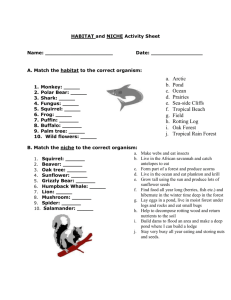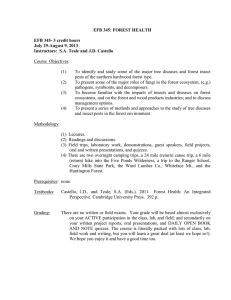PPT presentation
advertisement

Forest Watch: 20 Years in the Public Schools A New Hampshire Space Grant Consortium Success Story Forest Watch gives teachers and students: Exposure to academic challenges: • Botany • Math • Statistics • Physics • Satellite imagery • Calculus • Social studies • Comparative Forestry • Art and Literature Forest Watch Goals: • Hands-on/minds-on research • Authentic science • An interdisciplinary approach to learning • A true student and scientist partnership • An opportunity for students to become active contributors to an on-going research project. “Wind combers” White pine, Pinus strobus, an indicator species for ground-level ozone. New perspectives on nature • The size of the air pollution issue • The size of the organism affected • The power of students • The power of longterm studies • The power of analysis • The limits of knowledge • Daily change in the environment Oliver Morton says, “The tree’s form tells the truth. The tree grows into the air because it grows out of the air.” Lessons in the School Yard Sant Bani School trees in Sanbornton, NH, increased in girth or diameter at breast height (DBH) by 18.28 cm or 1.08 cm a year. The school's five white pines grew 0.58 meter taller year by year, adding 9.9 meters in height over the 17 years. Observation Questioning Journaling Collecting Safety Teamwork Sampling Measuring 258 schools in New England and the mid-Atlantic. 367 teachers 1767 white pine trees 3,497 field samples 6,994 needle samples. Learning in the Laboratory 196,132 bits of data from needle length to percent of tip necrosis. Biometric measures Microscopy Plant anatomy Ozone damage Data results Graphing Critical Thinking 21st Century Technologies Image sets for each school. Multispec interpretation and classification. Ground-truthing. Earth Systems Science Learning to Read Light NIR 1 REIP NIR3 Sample VIRIS, September 15, 2008 90 Leaf Pigments Tree 835 Tree 812 80 70 40 30 NIR, TM5 50 NIR, TM4 Percent Reflectance 60 Water 20 10 0 400 600 Blue Green Red Visible Light 800 1000 Near Infrared Light 1200 1400 1600 1800 2000 2200 2400 Wavelength (nm) “Can anyone explain what the Red Edge Inflection Point is?,” Dr. Rock asked. “A longer wavelength means this tree has more chlorophyll,” Sierra, 7th grader. Why Forest Watch Works 28,000 students in 20 years. Teachers can incorporate modules into required curriculum. A teacher’s talents and skill come to bear. Timing is flexible. The tree is in the school yard. Little or no costs. Supportive training and staffing. Web site resources. What’s Next for Forest Watch? New technologies? New pollutants? Unexpected occurrences? Phenologic change? An imperative need for more master teachers to teach and prepare the American public. Teaching Climate Change “Climate change is a highly interdisciplinary, pedagogically challenging subject that does not fit easily into discipline-based science curricula or assessments. However, a variety of factors—chief among them being barriers introduced by local STEM education policies and inadequate teacher preparation in this subject matter—prevent widespread exposure of learners to effective instruction on climate, or engagement of the most talented minds in climate-related education and career paths.” (NSF, 2010) “Student experiences should model the nature of science to illustrate the wonder and connections that make science real,” Louise James, 4th grade teacher, Sewall-Anderson School, Lynn, Massachusetts, laid off when science program was cut, 2008.











